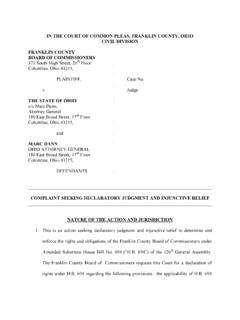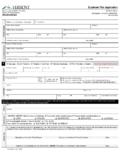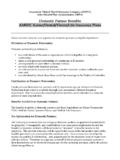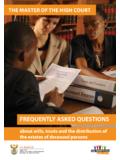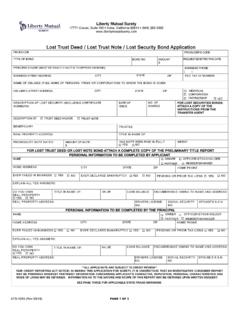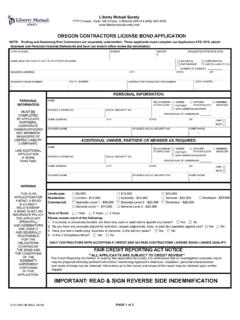Transcription of An analysis of the recent Court of Appeal decision in ...
1 An analysis of the recent Court of Appeal decision in Jacqueline Smith v Lancashire Teaching Hospital NHS Foundation Trust [2017]. EWCA Civ 1916. It might be thought that the recent Court of Appeal decision in this landmark case has the effect of bringing the law more into line with updated social norms in relation to marriage and cohabitation. It can only be hoped that its ultimate effect will be to enable an unmarried surviving partner from a relationship of two years or more, to be treated on an equal basis as a married partner or one in a civil partnership, so far as a bereavement award under s 1A of the Fatal Accidents Act 1976 is concerned. The background facts Ms Smith and Mr John Bulloch lived together as man and wife for 11 years before Mr Bulloch's death in October 2011 as a result of the admitted clinical negligence of the defendant NHS Trusts.
2 Ms Smith, as a 2 years + cohabitee, brought proceedings against the NHS Trusts for dependency damages under section 1 of the FAA. That claim was compromised and the NHS Trusts subsequently played no further part in the proceedings. Ms Smith did not make a claim against the Trusts, however, for bereavement damages under section 1A of the FAA, as such a claim is limited under section 1A(2)(a) to the wife or husband of the deceased, a civil partner or, where the deceased was a minor, his parents. The amended Particulars of Claim joined the Secretary of State and asserted that section 1A(2)(a) of the FAA was incompatible with Article 8 of the ECHR (the right to family life) and consequently in breach of Article 14 (prohibition on discrimination). It sought a declaration of incompatibility and/or damages for the (then) statutory amount of bereavement award of 11,800.
3 The issues on Appeal In order to bring herself within Article 14, Ms Smith did not have to show that the State had infringed her rights under Article 8, but only that her complaint fell within the ambit of Article 8. The main issue on Appeal therefore was whether the trial Judge was wrong to hold that the scheme for bereavement damages under section 1A of the FAA, and specifically its failure to extend such damages to 2 years + cohabitees, did not fall within the ambit of Article 8. for the purposes of Article 14. The Appellants argued that the correct test was whether the link with the rights protected by Article 8 was more than tenuous ; and, were that test to be applied correctly, the link between the right claimed by Ms Smith and the rights protected by Article 8, were thus established.
4 If that was correct, it was argued, then the Judge ought to have interpreted section 1A(2)(a) in such a way as to extend the right to bereavement damages to cohabitees (who had been together for more than 2 years). Alternatively, if that could not be done, the Court should make a declaration of incompatibility and award Ms Smith damages of 11,800. pursuant to section 8 of the HRA, The Secretary of State sought to uphold the judgment, adding that Ms Smith's situation did not fall within the ambit of Article 8 (contrary to the Judges findings) on the basis that her position was not analogous to the survivor of a civil partnership or marriage. The findings of the Court of Appeal The Court examined the ambit test for the purposes of Article 14 and concluded that the connection or link between the facts and the provisions of the Convention conferring substantive rights, must be more than merely tenuous [para 48].
5 Much emphasis was placed on the recent decision in Steinfeld v Secretary of State for Education [2017] EWCA Civ 81, The Master of the Rolls (who delivered the leading judgment) summarised the legal position at paragraph 55, stating that where the claim was that there had been an infringement of Article 14, in conjunction with Article 8, the claim was capable of falling within Article 14 even though there has been no infringement of Article 8. If the State has brought into existence a positive measure which, even though not required by Article 8, is a modality of the exercise of the rights guaranteed by Article 8, the State will be in breach of Article 14 if the measure has more than a tenuous connection with the core values protected by Article 8 and is discriminatory and not justified.
6 It is not necessary that the measure has any adverse impact on the complainant in a positive modality case other than the fact that the complainant is not entitled to the benefit of the positive measure in question.. At paragraph 72 the Court concluded that both the trial Judge and the Secretary of State wrongly relied upon the promotion of family life, as distinct from the promotion of respect for family life as specified in Article 8. It was clear, said the Master of the Rolls, from the very fact that bereavement damages were limited to the spouse or civil partner of the deceased, that they were specifically intended to reflect the grief that ordinarily flows from the intimacy which is usually an inherent part of the relationship between husband and wife and civil partners.
7 It inevitably followed, he said, that the scheme for bereavement damages was properly regarded as a positive measure, or modality, by which the State had shown respect for family life; a core value of Article 8. The Court concluded that the exclusion of unmarried cohabitees from obtaining bereavement damages under s1A, fell within the ambit of Article 8 as there was a clear link with the core value of respect for family life. They also agreed with the trial Judges'. conclusion that being in a stable, long term relationship was analogous to that of a surviving spouse or civil partner and that accordingly, to avoid breaching Articles 8 and 14, some justification for the discrimination caused by s 1A, was required. In determining that there was no coherent justification, the Court very much bore in mind:- 1.
8 That Parliament has treated 2 years + cohabitees as being in a stable and long term relationship as comparable to that of spouses and civil partners for the purposes of dependency damages under s 1 of the FAA;. 2. no member of the Government had sought to provide any justification for the different treatment of 2 years + cohabitees under section 1A.; and 3. the decline in popularity of the institution of marriage and the increase in the number of cohabiting couples, as found by the Office of National Statistics in a 2015 report Where Ms Smith was not successful was in persuading the Court of Appel to interpret s1A(2)(a), as though it extended to 2 years + cohabitees. The Court agreed with the trial Judge that such a construction was incompatible with the clear, expressed distinction set out between s1 and s1A.
9 All that was permissible therefore was a declaration of incompatibility, in accordance with section 4 of the HRA. A claim for damages of 11,800 was also sought by Ms Smith but on this issue the Court held that damages were not recoverable under s8 HRA, where the Court made a declaration of incompatibility, unless there was a finding that the public authority had acted unlawfully (s 6(1) of the HRA) and further, it was not unlawful if it had acted in accordance with primary legislation (and could not therefore have acted differently). Concluding observations There has long been a sense of grievance that damages for bereavement under s 1A of the FAA are available to married couples or those in a civil partnership, but not to those who are in a long term relationship.
10 The argument being that the grief and sense of loss is no different. This distinction is even more incongruous when compared with the right of cohabitees to seek (the inevitably larger) award for loss of dependency under s1 of the FAA and their ability to receive a bereavement award if the claim is sought under the 2012. Criminal Injuries Compensation Scheme their loved one has been killed in the course of a crime. Whilst this case is clearly not the end of the inequality that currently exists, it does seem that it is the beginning of the end. It is notable that this was a victory of principle rather than of substance, in that whilst incompatibility with Article 8 was established, no award of damages was forthcoming. It can only be hoped that the consequences of this landmark decision lead to a (modest).
